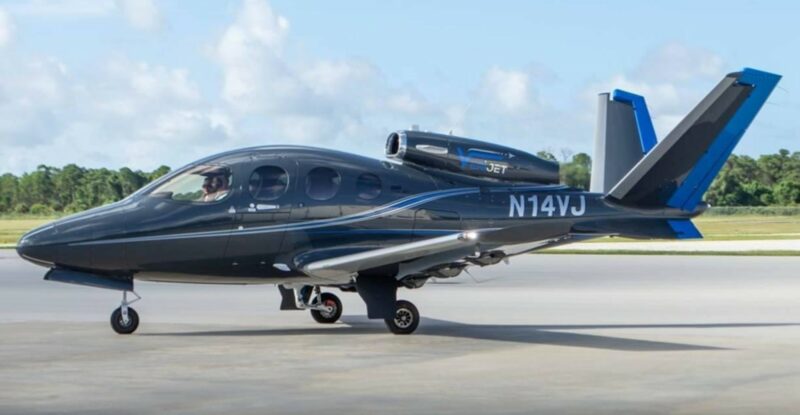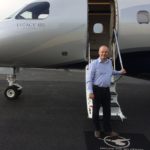After his company Coastal Technologies helped to transform the US telecommunications market with call routing software, Richard Kane realized that the same high-speed computing and AI technologies used by Coastal were applicable to any system where routing was key to efficiency. He and fellow pilot, Dr Peter Diamandis, identified business aviation charters as one such area.
Together, Kane and Diamandis combined their passions for aviation and mathematics, and before long, several bizjet operators were benefitting from their route optimisation AI solution.
But Kane wanted to do more. Routes could be optimized, saving millions of gallons of Jet A and tons of carbon, but in his view, the industry was still flying too-large aircraft with small payloads — averaging 1.8 passengers and, on occasion, a dog — over short legs on which efficient cruising altitudes and speeds were never reached.
Setting out to revolutionize private flying, he launched Florida-based private jet company and AI-powered air taxi service Verijet, with Diamandis serving as a board member.
Kane went on to select an aircraft type that he reckons is better suited to the average US private aviation charter — one that carries those 1.8 passengers less than 600 miles at an average speed of 243kt. He found it in the affordable, low-emission Cirrus Vision Jet G2.
Powered by a single Williams FJ44 turbofan, the Cirrus Vision Jet G2 delivers exceptional fuel economy. Its deceptively spacious cabin and range are easily up to the job, while its composite construction means airframe fatigue is not going to be an issue over multiple short sectors.
Any reservations passengers have over flying in the unusual looking, diminutive jet are overcome as soon as they experience its spectacular visibility and smooth ride, according to Kane.
Reducing emissions was a primary driver from the outset and Kane says that while a typical mid-size jet flying between Santa Monica and Las Vegas might burn 300 gallons of fuel, the Vision Jet consumes only 60 gallons; and it’s better suited to Santa Monica’s short runway. Better still, Verijet is certified carbon neutral through 4AIR, which provides sustainability ratings in industry.
“All Verijet flights are 100% carbon neutral,” boasts the operator. “This is our reality today, not a pledge in the future. Travelers can fly confidently, knowing that their flight has zero carbon impact. Verijet currently offers services in the Northeast, the Southeast, and the Western US.”
Carbon offsetting plays a role. Yet still, Kane wants more. By the end of 2022, the Verijet founder and CEO expects to have 20 Vision Jets in passenger service in the US, growing to a 120-strong fleet by 2025. He says the product will launch in Europe too, but declines to reveal timings. Notably, he confidently predicts that Verijet will soon be a totally carbon zero operation.
On 25 October 2022, during the 77th session of the UN General Assembly and 14th Climate Week, Kane announced a LOI with Dimensional Energy, under which Verijet will purchase a minimum of 750,000 gallons of sustainable aviation fuel (SAF) by 2025.
“Dimensional Energy is an XPRIZE winning team,” notes Kane. “I’ve been part of XPRIZE since just after its inception — I was among the original 100 people who funded it. Dimensional Energy won a ‘make products out of carbon’ XPRIZE for jet fuel. Simply put, they make sustainable jet fuel out of air and water…”
Direct air capture is gaining increasing attention, and indeed funding, in industry. But while Kane is reluctant to reveal the exact details of the process being used by Dimensional Energy for Verijet, the air component is essentially carbon dioxide.
“The key to this is clean electricity to electrolyse water and generate hydrogen, so Dimensional Energy’s first plant will be close to Niagara Falls, using truly hydroelectric power. United Airlines and Verijet are their launch customers. Today, Verijet is carbon neutral; with their fuel we’ll be carbon zero and 750,000 gallons of fuel will be sufficient for the 120-aircraft fleet I propose,” he explains.
“We’ll be flying carbon zero, directly connecting city pairs [that] the airlines can’t serve, because their runways are too short and they don’t have the financial model to support them; in the US, that’s 5,400 airports, in Europe it’s 3,000. At that point, all the barriers to the widespread adoption of private flying disappear.”
Related Articles:
- Aviation industry starts to pour money into carbon-removal tech
- CO2 sucked from the air and turned into jet fuel shows promise
- Lufthansa Systems helps airlines go green with cadre of digital tools
- US general aviation embarks on important transition to unleaded avgas
- Textron looks to realize electric GA and UAM ambitions
Featured image credited to Verijet














